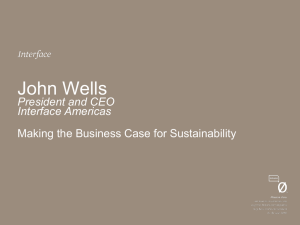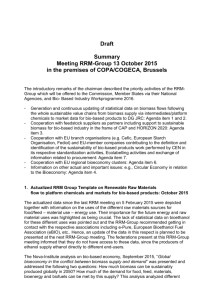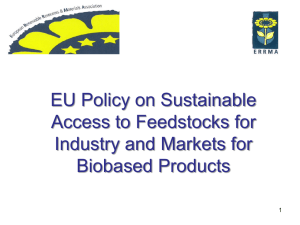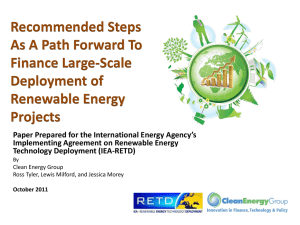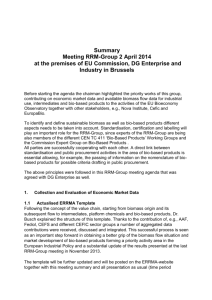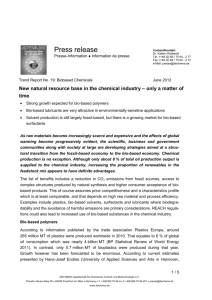Chemical Enterprise
advertisement
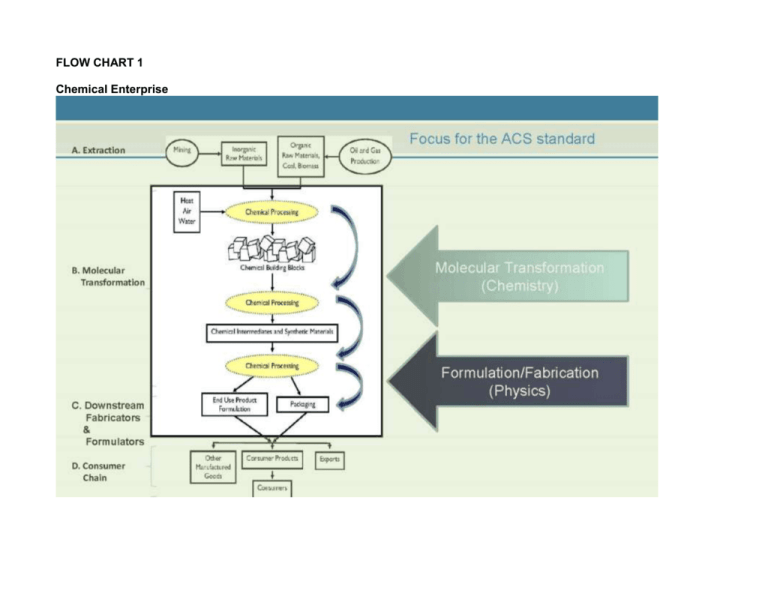
FLOW CHART 1 Chemical Enterprise FLOW CHART 2A Recycled / Reused Material input Virgin Material input Renewable Material input Recycled / Reused Material input Material to Recycle / Reuse Chemical Transformation Process (step 1) Waste (air, solid waste, wastewater) Intermediates Material to Recycle / Reuse Virgin Material input Renewable Material Chemical Transformation Process (step 1+n) input Product and Co-productoutput Waste (air, solid waste, wastewater) FLOW CHART 2B (overall view to see where renewable fits for the standard) (RESOURCE CATEGORIES) (PER UNIT PRODUCT) RESOURCES INPUT 1. Chemicals 2. Water 3. Energy CHEMICAL TRANFORMATION 1. Net process chemicals (includes water) 2. Net co-process water 3. Net energy (process and co-process) (PER UNIT PRODUCT) WASTE MATATERIALS 1. Net Regulated Waste and GHG’s 2. Includes solid, liquid and gas waste. Recycled / Reused Material input Virgin Material input Renewable Material input Chemical Transformation Process Product and Co-productoutput CHEMICAL PRODUCTS and CO-PRODUCT OUTPUT 1. Net chemical products and co-products generated per resources utilized EVALUATTION OF CHEMICAL PRODUCTS 1. TBD (e.g. spider chart) RESOURCE CATEGORIES 1. Chemical resource categories – (a) virgin, reusable, recyclable and renewable 2. Water resource categories – (a) sustainable (b) un-sustainable (c) water type 3. Energy resource categories – (a) renewable, (b) non-renewable Material Going to Recycle / Reuse Waste (air, solid waste, wastewater) JC COMMENT – DEFINE RENEWABLE MATERIALS FOR STANDARD… Below is an example approach… Renewable Materials INPUT (flow chart 1) Raw materials are provided by a supplier. The following are categories of raw materials that a supplier may provide to a chemical manufacturer: Extraction Type Mining Oil and Gas Nature Agriculture ???? Sustainable? If available If available If available If available If available Raw Material Type In-organic Organic bio-based fossil (old growth) Organic bio-based non-fossil (new growth) Organic bio-based non-fossil (new growth) Organic non-bio-based Renewable No No Yes Yes No From the above, bio-based non-fossil is the renewable type material from nature and or agriculture. The information delivered to the chemical manufacturer by the supplier. If a raw material type is not made available by the supplier or is not known, the following approach may be utilized as an option to provide the above required information: 1. Chemical composition of the material determined. Are the chemical(s) organic or in-organic? 2. If organic, is it bio-based or non-bio-based? If bio-based, fossil or non-fossil? This may be determined via the ASTM methods listed in the developed spreadsheet (prior work). 3. For organic materials, the degradability may be determined via the ASTM methods listed in the developed spreadsheet…. Reused or Recycled Content Materials Reused or recycled content material may be obtained from two basic sources: 1. Inside the chemical transformation gate (known by the chemical manufacturer inherent to chemical process) 2. From an outside source on-site or off-site (made known by the supplier of the chemical; no method available to determine if the supplier does not provide the information) Bioproducts or Bio-based Products are materials, chemicals and energy derived from renewable biological resources.[1][2][3] Biological resources include agriculture, forestry, and biologically-derived waste, and there are many other renewable bioresource examples. One of the scientific terms used to denote renewable bioresources is lignocellulose. Lignocellulosic tissues are biologically-derived natural resources containing some of the main constituents of the natural world. 1) Holocellulose is the carbohydrate fraction of lignocellulose that includes cellulose, a common building block made of sugar (glucose) that is the most abundant biopolymer, as well as hemicellulose. 2) Lignin is the second most abundant biopolymer. Cellulose and lignin are two of the primary natural polymers used by plants to store energy as well as to give strength, as is the case in woody plant tissues. Other energy storage chemicals in plants include oils, waxes, fats, etc., and because these other plant compounds have distinct properties, they offer potential for a host of different bioproducts [4][5] Conventional Bioproducts and Emerging Bioproducts are two broad categories used to categorize bioproducts. Examples of conventional bio-based products include building materials, pulp and paper, and forest products. Examples of emerging bioproducts or bio-based products include biofuels, bioenergy, starch-based and cellulose-based ethanol, bio-based adhesives, biochemicals, biodegradable plastics, etc.[6][7] Emerging bioproducts are active subjects of research and development, and these efforts have developed significantly since the turn of the 20/21st century, in part driven by the price of traditional petroleum-based products, by the environmental impact of petroleum use, and by an interest in many countries to become independent from foreign sources of oil. Bioproducts derived from bioresources can replace much of the fuels, chemicals, plastics etc. that are currently derived from petroleum [8] Biomass Research and Development BioPreferred National Renewable Energy Laboratory - Fostering Bio-economy U.S. DOE Biomass Program ABCs of bioproducts USDA Bio-based Products Biomass Energy Research Association Energy Title (Title IX) of the Farm Security and Rural Investment Act of 2002 BioPreferred Program : Official site of the BioPreferred program Renewable Fuels Association : Association dedicated to supporting the use of ethanol by promoting policies, regulations, and research. United Soybean Board : Promotes the use of U.S. grown soybeans in consumer and industrial products. U.S. EPA Methane Minnesota Biomass Exchange Planet Power Technical Association of the Pulp and Paper Industry Forest Products Society References 1. ^ Singh, S.P., Ekanem, E., Wakefield, T. Jr., and Comer S. (2003) “Emerging importance of bio-based products and bioenergy in the U.S. economy: information dissemination and training of students.” International Food and Agribusiness Management Review Vol. 5(3) 2. ^ Biomass Research and Development Initiative, 2006: Vision for Bio-energy and Bio-Products in the United States – Bio-economy for a Sustainable Future 2006 http://www1.eere.energy.gov/biomass/pdfs/final_2006_vision.pdf 3. ^ National Research Council, 2000. Bio-based industrial products: priorities for research and commercialization. National Academy Press, Washington DC 4. ^ Bowyer, J.L., Ramaswamy, S., 2005: “Redefining undergraduate education for the 21st Century: Minnesota moves aggressively to strengthen program” Forest Products Journal, July-Aug 2005, 55 (7-8): 4-10) 5. ^ Ramaswamy, S., Tschirner, U., Chen, Y., 2007: “Transforming Academic Curricula: Pulp and Paper to Bio-based Products - Providing Education and Research Training for the Conventional and Emerging Bio-based Products Industry and the Bio-economy” ACS Symposium Series Chapter 4, Section 1, Materials, Chemicals and Energy from Forest Biomass Ed. by Argyropoulos. 6. ^ Bowyer, J.L., Ramaswamy, S., 2005: “Redefining undergraduate education for the 21st Century: Minnesota moves aggressively to strengthen program” Forest Products Journal, July-Aug 2005, 55 (7-8): 4-10) 7. ^ Ramaswamy, S., Tschirner, U., Chen, Y., 2007: “Transforming Academic Curricula: Pulp and Paper to Bio-based Products - Providing Education and Research Training for the Conventional and Emerging Bio-based Products Industry and the Bio-economy” ACS Symposium Series Chapter 4, Section 1, Materials, Chemicals and Energy from Forest Biomass Ed. by Argyropoulos. ^ http://www.nrel.gov/learning/re_bioproducts.html Retrieved from "http://en.wikipedia.org/wiki/Bioproducts"

